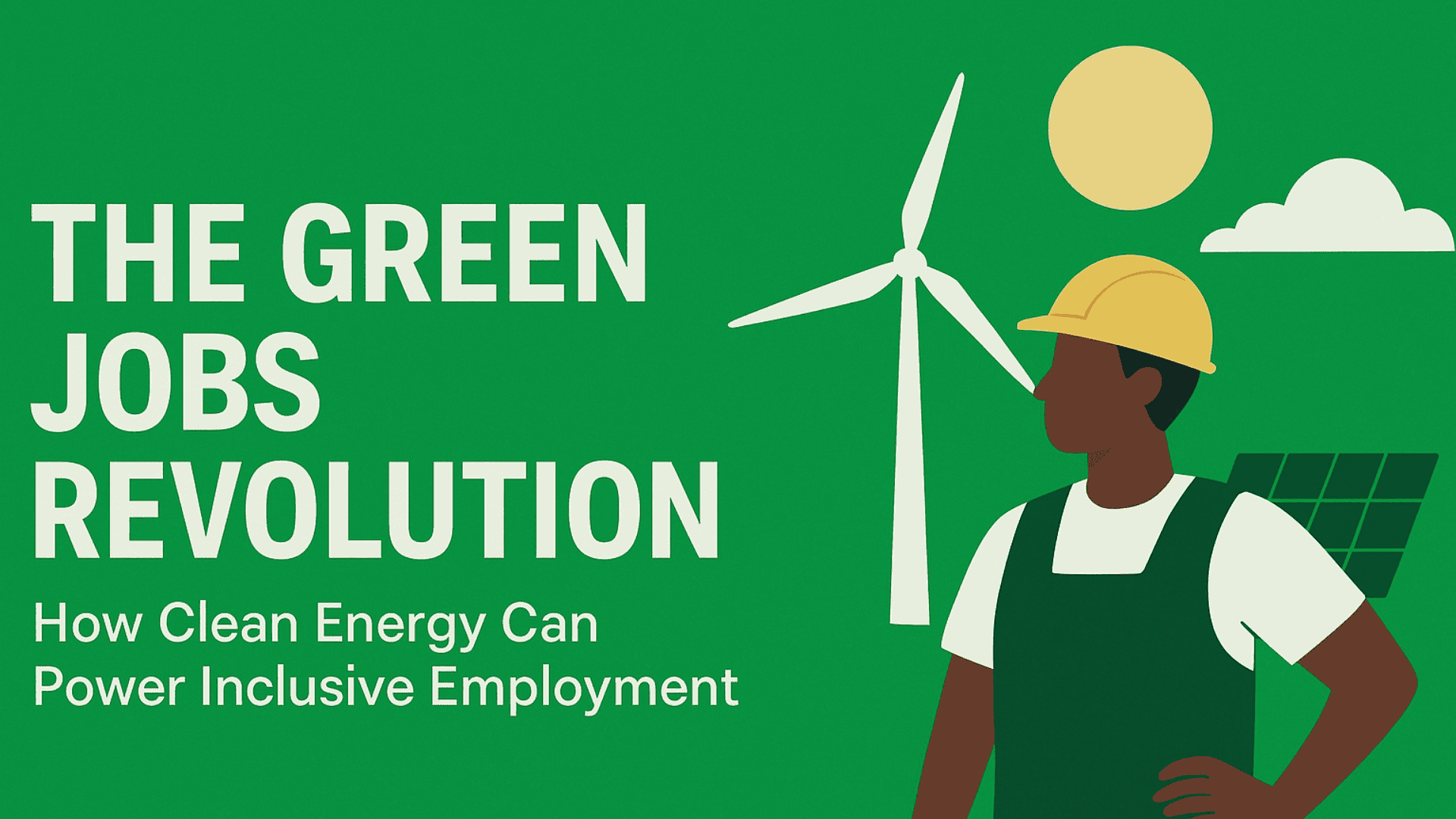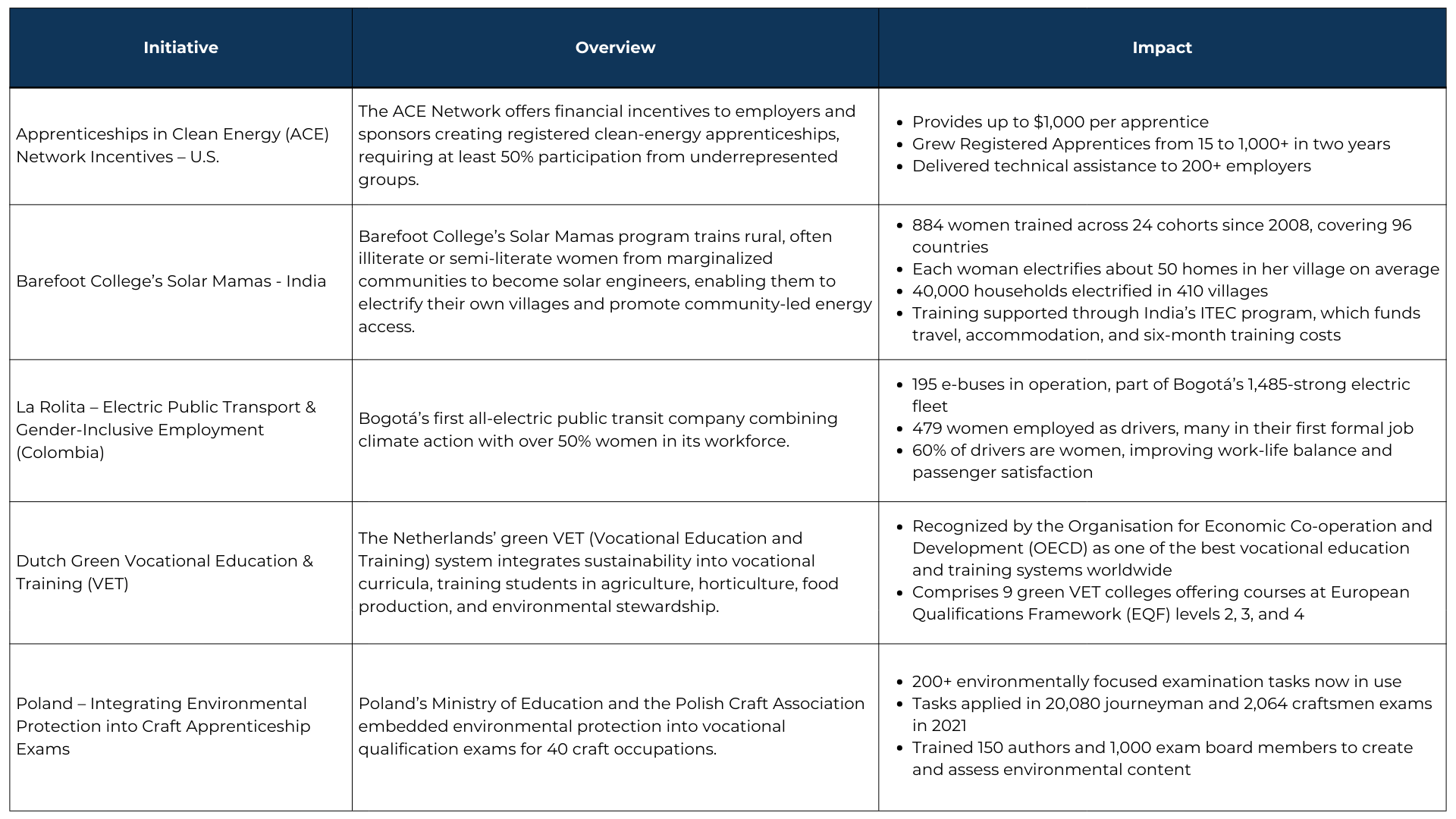
14 Aug The Green Jobs Revolution: How Clean Energy Can Power Inclusive Employment
A Counter‑Trend to AI Layoffs: Clean Energy’s Job Creation Boom
Headlines today are dominated by fears of artificial intelligence replacing workers, with tech sector layoffs amplifying anxieties about the future of work. Yet amid this disruption, a very different labor story is emerging: one of job creation, not loss. The global push toward 100% clean energy is generating millions of new opportunities in solar, wind, grid modernization, and green manufacturing.
These roles, broadly referred to as green jobs, encompass employment that contributes to preserving or restoring the environment, whether through renewable energy, energy efficiency, pollution reduction, or sustainable resource management.
This trend offers a rare counter narrative: while some industries contract, the clean energy transition is expanding the workforce, but only if we can equip people with the right skills in time.
Racing Toward a Clean Energy Future, But Lacking the Skills to Get There
Clean energy job growth is accelerating worldwide. According to a study by the International Renewable Energy Agency (IRENA) and the International Labour Organization, green jobs rose from 13.7 million in 2022 to 16.2 million in 2023.

(Source: World Economic Forum)
The 2023 estimates highlight a significant global shift toward sustainability-driven employment, with China leading at 7,388 thousand green jobs, followed by the EU, Brazil, India, and Africa. This upward trend reflects growing investments in renewable energy, sustainable agriculture, and eco-friendly infrastructure, underscoring how green industries are becoming major drivers of job creation worldwide.
However, the supply of skilled workers is far behind. Reports suggest a global shortfall of 7 million skilled green workers by 2030, particularly in solar, wind, and biofuels. LinkedIn reports that the demand for green skills is growing at 22% annually, while the supply of workers is only growing at 12%.
This isn’t just a labor challenge; it’s a climate risk. Projects are delayed, costs rise, and communities miss out on equitable economic benefits when there aren’t enough qualified workers.
Bridging the Gap: Training and Policies to Power the Green Workforce
Closing this gap requires coordinated action across training programs, reskilling initiatives, and supportive policies:
- Rapid Training Models: Short‑cycle programs like micro‑credentials, bootcamps, apprenticeships, and certifications allow faster entry into the workforce and upskilling of mid‑career workers.
- Skill‑Based Hiring: Moving from degree‑focused to competency‑based recruitment widens the talent pool and allows non‑traditional candidates to enter green roles.
- Industry‑Education Partnerships: Partnerships between employers, vocational institutions, and universities ensure curricula match industry needs and provide hands‑on experience.
- Inclusive Support Systems: Embedding childcare, transportation, and digital literacy support improves participation from under‑represented groups, including women and marginalized communities.
What Success Looks Like: Best Practices with Measurable Impact

While these initiatives highlight what’s possible when training and resources align, many regions still face systemic barriers that limit the scale and accessibility of green job opportunities.
Barriers to Overcome
- Funding gaps make training inaccessible for many, particularly in low‑income regions.
- Geographic mismatch between fossil‑fuel workers and emerging green job hubs complicates transitions.
- Slow institutional scaling: Vocational programs are struggling to meet the pace of demand.
- Cultural resistance: Communities may perceive green projects as externally imposed unless training and hiring are localized.
- Gender imbalance: According to the IEA, women account for just 32% of the renewable‑energy workforce globally, with representation dropping even further in technical and leadership roles.
Reframing the Future of Work
While AI‑driven layoffs dominate headlines and fuel anxieties about technological displacement, the clean‑energy sector offers a counter‑narrative of creation and inclusion that can redefine the future of work if acted on now. Bridging the green skills gap is critical not just for meeting climate targets but also for ensuring this transition benefits those most at risk of being left behind. The Frost and Sullivan Institute views investment in people through modular training, employer‑education partnerships, inclusive support systems, and just‑transition frameworks as central to accelerating 100 percent clean energy while fostering equitable prosperity. A workforce prepared for this shift is not only a climate imperative; it is also a social and economic opportunity we cannot afford to miss.
Blog by Sakthi Kumararaja,
Associate, Frost & Sullivan Institute
